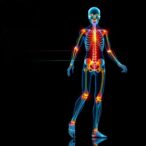
A groundbreaking new study has unveiled a complex genetic link that intertwines eating disorders, various mental health conditions, and cardiometabolic diseases, signaling a major leap forward in our understanding of these often co-occurring health challenges. Conducted across two entire populations, this unprecedented investigation consolidates genetic data with clinical outcomes, revealing shared biological pathways that could revolutionize diagnostics and therapeutic strategies in the near future.
For decades, researchers have observed that eating disorders such as anorexia nervosa, bulimia nervosa, and binge-eating disorder rarely occur in isolation. These disorders frequently coincide with anxiety, depression, and other psychiatric conditions, while simultaneously increasing the risk of cardiometabolic complications like obesity, type 2 diabetes, and cardiovascular disease. Despite clinical awareness of these overlaps, the precise genetic and molecular mechanisms underlying these intersecting disorders have remained largely elusive—until now.
The study, rigorously designed and powered by extensive population-wide genomic datasets, leveraged cutting-edge statistical genetics techniques coupled with comprehensive patient records from two distinct countries. This dual-nation approach provided a robust validation platform, minimizing demographic and environmental confounders typically challenging for genetic epidemiology. By integrating genome-wide association studies (GWAS) with polygenic risk scoring and advanced machine learning algorithms, the researchers teased apart the shared heritable components that transcend traditional diagnostic boundaries.
.adsslot_c4IT1OPLRu{ width:728px !important; height:90px !important; }
@media (max-width:1199px) { .adsslot_c4IT1OPLRu{ width:468px !important; height:60px !important; } }
@media (max-width:767px) { .adsslot_c4IT1OPLRu{ width:320px !important; height:50px !important; } }
ADVERTISEMENT
One of the most striking revelations was the identification of significant genetic correlations between eating disorders and a broad spectrum of mental health conditions beyond the usual suspects like depression and anxiety. Bipolar disorder, schizophrenia, and post-traumatic stress disorder exhibited heritable overlaps, suggesting a common neurobiological substrate influencing susceptibility. These insights challenge the siloed approach in psychiatry and emphasize a more integrated model of mental health where genetic pleiotropy plays a crucial role.
The genetic architecture also linked eating disorders with cardiometabolic diseases, shedding light on why patients often present with both sets of conditions clinically. Variants in genes regulating metabolism, lipid homeostasis, and glucose control were found to overlap with those influencing appetite regulation and neurocircuitry involved in reward and compulsive behaviors. This dual interplay may explain the paradoxical coexistence of restrictive eating patterns with metabolic dysregulation in certain patient subgroups.
Further dissecting the implicated genomic regions uncovered pathways implicated in inflammatory responses and mitochondrial function, both increasingly recognized as crucial in neuropsychiatric and metabolic disorders. The mitochondrial dysfunction nexus offers a tantalizing biological explanation for the systemic manifestations often observed in patients suffering from eating disorders accompanied by cardiometabolic complications.
From a methodological standpoint, the integration of national biobanks and electronic health records created a colossal dataset ideal for phenome-wide association studies (PheWAS). This holistic approach ensured that subtle genetic signals associated with rare comorbidities were not missed. Additionally, cross-validation between cohorts from different ethnic and environmental backgrounds enhanced the generalizability of findings, overcoming a common limitation in genetic research that often suffers from population stratification biases.
Clinically, these findings hold profound implications. Genetic profiling could become a critical ingredient in early risk stratification, enabling personalized interventions that address not only the primary eating disorder but also mitigating the emergence of secondary mental health and cardiometabolic conditions. Such predictive precision medicine approaches could drastically reduce morbidity and mortality rates, which remain alarmingly high for these interlinked diseases.
Moreover, the discovery prompts reevaluation of current therapeutic targets. Pharmacological interventions, traditionally designed to treat isolated symptoms, might be improved by drugs modulating shared pathways, such as mitochondrial bioenergetics or inflammatory cascades. This could usher in a new era of multidimensional treatment paradigms that are more efficient and holistic in restoring patient health.
Importantly, the study also touches on the significance of environmental and lifestyle factors as modulators of the genetic risk uncovered. While genetics provide a foundational blueprint, interactions with nutrition, physical activity, and psychosocial stressors were acknowledged as essential determinants shaping the phenotypic expression of these disorders. Future research integrating epigenomics and exposomics could unravel how external influences mediate gene expression in this multifaceted disease network.
Ethical considerations have also been brought to the forefront by the authors, emphasizing the responsible use of genetic information. While genetic screening promises benefits, it must be balanced against risks related to stigmatization and privacy. The study advocates for frameworks ensuring equitable access to genetic counseling and fostering informed decision-making among patients and healthcare providers.
From a broader scientific perspective, this research advances the paradigm of psychiatric and metabolic illnesses as interconnected biological syndromes rather than isolated conditions. It underscores the need for interdisciplinary collaborations across genetics, neuroscience, endocrinology, and clinical psychology to translate these molecular insights into tangible health outcomes.
Overall, this comprehensive population-wide study charts an ambitious course toward unraveling the intricate genetic fabric that connects eating disorders with mental health and cardiometabolic diseases. Its findings heighten our appreciation of the biological complexity and open compelling avenues for innovative interventions. As genomic technologies continue to evolve, such integrative research heralds a promising future with improved diagnosis, prevention, and personalized care for millions affected worldwide by these interlinked disorders.
Subject of Research: Shared genetic architecture linking eating disorders, mental health conditions, and cardiometabolic diseases.
Article Title: Shared genetic architecture between eating disorders, mental health conditions, and cardiometabolic diseases: a comprehensive population-wide study across two countries.
Article References:
Meijsen, J., Hu, K., Wei, D. et al. Shared genetic architecture between eating disorders, mental health conditions, and cardiometabolic diseases: a comprehensive population-wide study across two countries. Nat Commun 16, 6193 (2025). https://doi.org/10.1038/s41467-025-61496-5
Image Credits: AI Generated
Tags: advanced statistical genetics techniquesanorexia nervosa genetic risk factorsbinge-eating disorder and obesitybulimia nervosa and cardiovascular healtheating disorders and mental health geneticsGenetic epidemiology of eating disordersgenetic links between mental health and cardiometabolic diseasesmental health comorbidities in eating disorderspolygenic risk scoring in health researchpopulation-wide genomic studiesrevolutionary diagnostics for eating disordersshared biological pathways in health disorders



